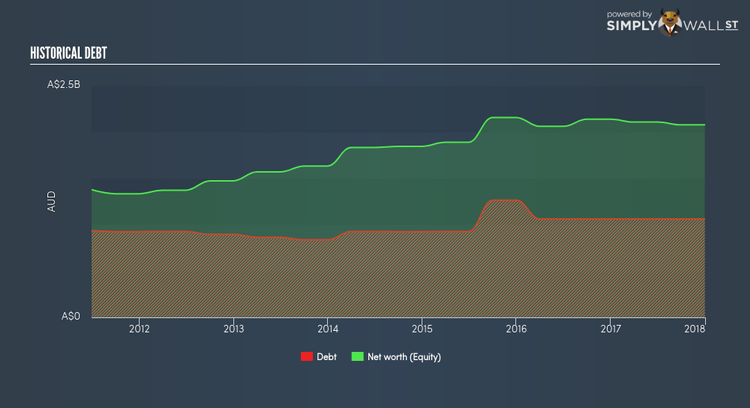Spark Infrastructure Group (ASX:SKI): Time For A Financial Health Check

Small and large cap stocks are widely popular for a variety of reasons, however, mid-cap companies such as Spark Infrastructure Group (ASX:SKI), with a market cap of AU$3.73B, often get neglected by retail investors. However, history shows that overlooked mid-cap companies have performed better on a risk-adjusted manner than the smaller and larger segment of the market. This article will examine SKI’s financial liquidity and debt levels to get an idea of whether the company can deal with cyclical downturns and maintain funds to accommodate strategic spending for future growth. Remember this is a very top-level look that focuses exclusively on financial health, so I recommend a deeper analysis into SKI here. Check out our latest analysis for Spark Infrastructure Group
How does SKI’s operating cash flow stack up against its debt?
Over the past year, SKI has maintained its debt levels at around AU$1.06B made up of current and long term debt. At this constant level of debt, SKI currently has AU$117.29M remaining in cash and short-term investments for investing into the business. Moreover, SKI has produced AU$185.75M in operating cash flow during the same period of time, leading to an operating cash to total debt ratio of 17.50%, signalling that SKI’s debt is not appropriately covered by operating cash. This ratio can also be interpreted as a measure of efficiency as an alternative to return on assets. In SKI’s case, it is able to generate 0.17x cash from its debt capital.
Does SKI’s liquid assets cover its short-term commitments?
With current liabilities at AU$63.22M, the company has been able to meet these obligations given the level of current assets of AU$128.38M, with a current ratio of 2.03x. For Electric Utilities companies, this ratio is within a sensible range since there is a bit of a cash buffer without leaving too much capital in a low-return environment.
Does SKI face the risk of succumbing to its debt-load?
SKI is a relatively highly levered company with a debt-to-equity of 51.13%. This is not unusual for mid-caps as debt tends to be a cheaper and faster source of funding for some businesses. No matter how high the company’s debt, if it can easily cover the interest payments, it’s considered to be efficient with its use of excess leverage. A company generating earnings after interest and tax at least three times its net interest payments is considered financially sound. In SKI’s case, the ratio of 2.22x suggests that interest is not strongly covered, which means that debtors may be less inclined to loan the company more money, reducing its headroom for growth through debt.
Next Steps:
SKI’s cash flow coverage indicates it could improve its operating efficiency in order to meet demand for debt repayments should unforeseen events arise. However, the company exhibits an ability to meet its near term obligations should an adverse event occur. I admit this is a fairly basic analysis for SKI’s financial health. Other important fundamentals need to be considered alongside. I recommend you continue to research Spark Infrastructure Group to get a better picture of the stock by looking at:
Future Outlook: What are well-informed industry analysts predicting for SKI’s future growth? Take a look at our free research report of analyst consensus for SKI’s outlook.
Valuation: What is SKI worth today? Is the stock undervalued, even when its growth outlook is factored into its intrinsic value? The intrinsic value infographic in our free research report helps visualize whether SKI is currently mispriced by the market.
Other High-Performing Stocks: Are there other stocks that provide better prospects with proven track records? Explore our free list of these great stocks here.
To help readers see pass the short term volatility of the financial market, we aim to bring you a long-term focused research analysis purely driven by fundamental data. Note that our analysis does not factor in the latest price sensitive company announcements.
The author is an independent contributor and at the time of publication had no position in the stocks mentioned.

